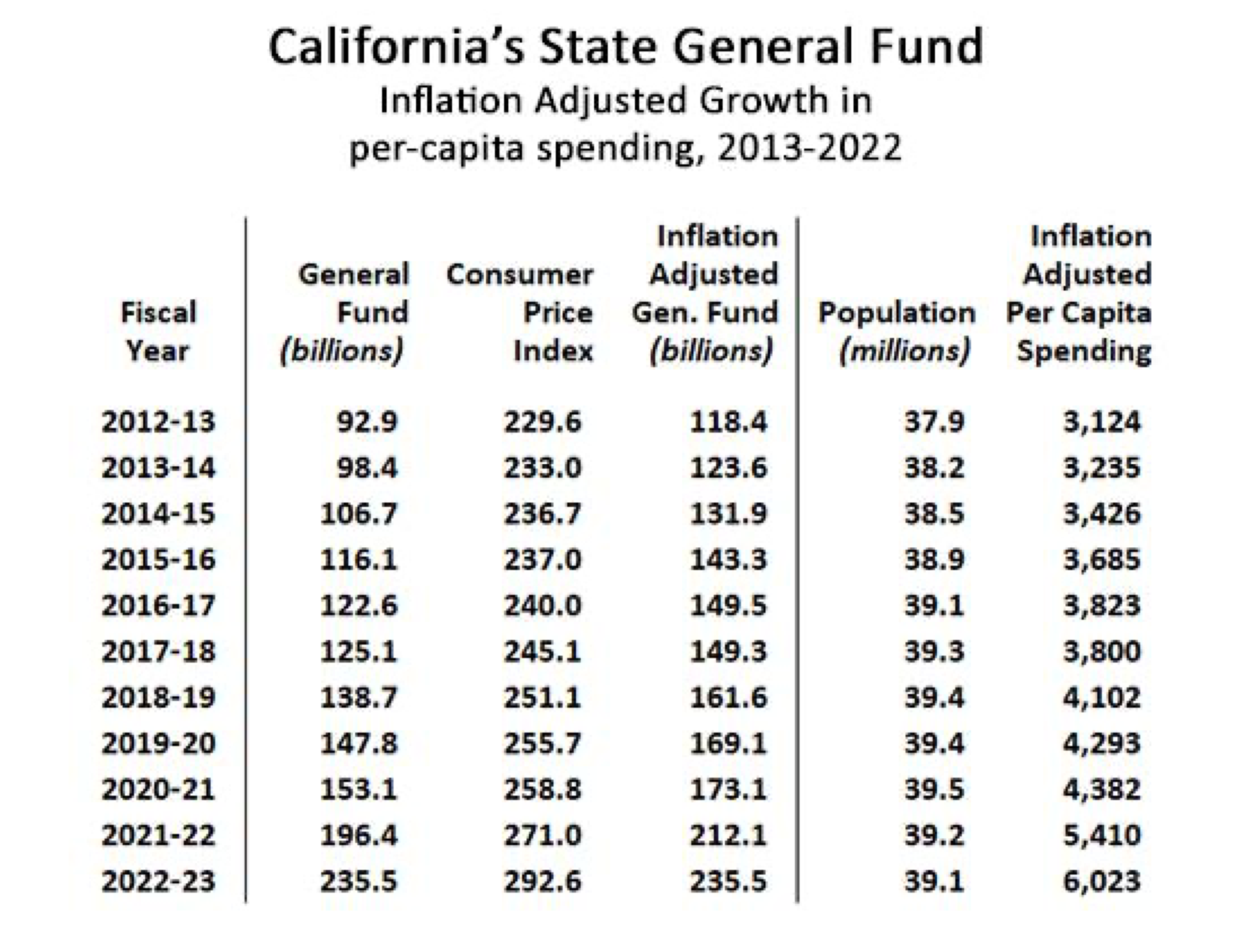

By Edward Ring
The California State Legislature has just released the “Floor Report of the 2022-2023 Budget,” and it’s a doozy. Representing an agreement between the budget committees of the Assembly and the Senate, and building on Governor Newsom’s proposal, this $300 billion monstrosity has moved one step closer to becoming final.
To fully appreciate how out of control California’s state government spending has become, compare the general fund spending growth over just the past ten years. The following chart, relying on official state budget reports going back to 2012-13, shows California’s General Fund spending by year. Back then, the general fund was $92.9 billion. Adjusting for inflation and expressing this amount in 2022 dollars, the 2012-13 general fund was $118.4 billion, barely half the swollen $235.5 billion that is projected for the upcoming budget year.
When you take into account the fact that California’s population has only increased by 3.1 percent in the past decade (it’s actually declined for the past two years), this budget profligacy becomes even more inexplicable. The inflation adjusted (i.e., in 2022 dollars) per capita general fund spending ten years ago was $3,124. It has now exploded to $6,023 per person. What has the average Californian gotten for all that extra money, apart from taxes that are higher than ever, and set to go even higher?


By almost every objective measure, Californians are worse off today than ten years ago. Back in June 2012, the average cost of a home in California was an already outrageous $307,000 ($391,000 in 2022 dollars). As of June 2022, the average cost of a home in California is just over $800,000.
Every basic necessity in California costs more: gasoline, electricity, and water. The only commodity where Californians still pay prices competitive with the rest of the U.S. is for fruit and vegetables, but regulators are fast closing in on that last advantage. Just ask a farmer that’s trying to get water allocations from a state bureaucracy committed to letting every precious drop of rain in these dry years run out to sea. And they’re doing this during a global food crisis.
What about crime? Homelessness? Is California better off today than it was ten years ago? Drive down any urban boulevard, or up any freeway onramp, and survey the expanse of tents and makeshift shacks. Did you see that ten years ago? The state’s answer? Turn tens of billions of dollars over to developers and “nonprofits” to build “permanent supportive housing” at an average cost of $500,000 per unit. These unfortunate souls could easily be rounded up and given inexpensive shelter, and required to maintain sobriety, and if that happened they’d either go back to Arkansas, or they’d finally have a chance to recover their dignity. Instead, while the homeless industrial complex scams taxpayers for additional billions, they frequent “safe injection sites” while living in squalor.
What’s happened in California, and it’s being exported to the rest of the United States, is an out-of-control public sector has imposed a regulatory burden on businesses that has driven prices up, destroying small businesses, and enabling big corporations to consolidate markets.
Excessive building codes and permitting fees are a perfect example. Builders in California are required to comply with so many mandated construction codes, and obtain so many permits, from so many agencies, that only the biggest and most politically connected development corporations can still make money. Smaller operators are driven out of the business, not only including the smaller construction companies, but mom and pop landlords. As these barriers fall into place, entire neighborhoods are bought up by investment funds. Thanks to the crippling burden of regulations, the last avenue towards building generational wealth in California, real estate, has been taken away from all but the wealthiest families.
This is the story of California in the early 21st century. A voracious state government has created shortages and high prices through overregulation, then as people are impoverished by its actions, it has used that to justify expensive new programs and expanded state bureaucracies. Failed policies, for California’s state government, constitutes success, as taxes are raised and even more regulations are enacted to cope with the problems it created.
No wonder the inflation-adjusted per capita state General Fund spending has doubled in the past decade.
TELL YOUR FRIENDS ABOUT CITIZENS JOURNAL Help keep us publishing –PLEASE DONATE




Ok, I get the slam to my native Arkansas, as I just returned from attending a funeral.
Heat /humidity not withstanding, it IS green & beautiful, but most importantly -AFFORDABLE!!
Does take the strong to live there!